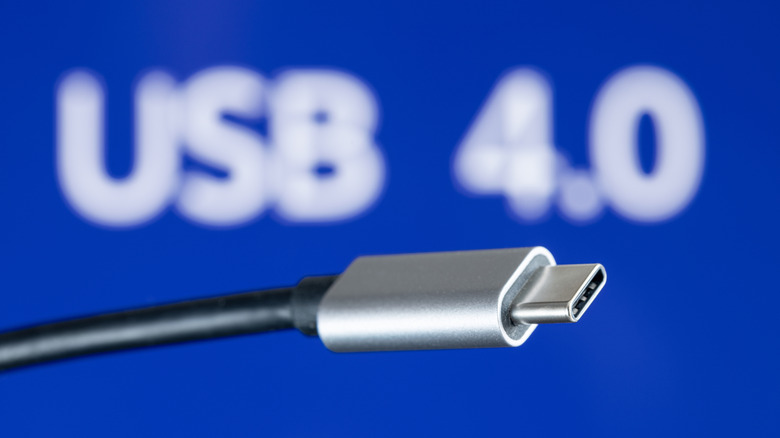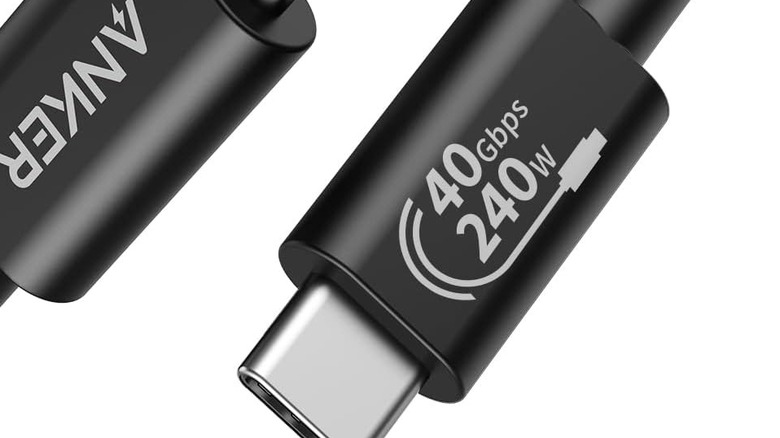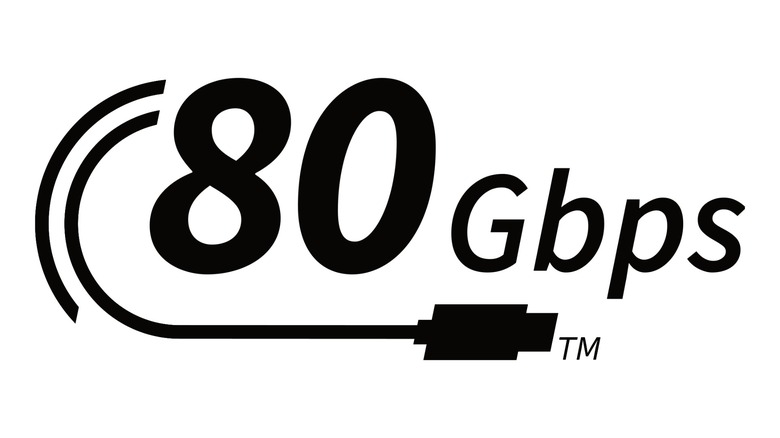How Fast Is USB4? (And How To Know If Your Laptop Has This USB Port)
The fourth generation of USB has given consumers the fastest type of USB port on the market right now, and it's been making its way into laptops and other electronics for the past several years. With 40-80 gigabits per-second (Gbps) speeds double to quadruple those of the fastest USB 3.2 ports, USB4 makes it easier than ever to transfer large files in mere moments, or to charge devices to full power in record time. It may even unlock new gaming potential for external GPUs. But not all new devices include USB4, even on the high end of the market. Don't expect to see it on your new Android phone or iPhone, for example, and be prepared to wade through spec sheets when looking for it on a new laptop.
Although new products with USB4 are consistently being released, they remain puzzlingly rare. When it comes to the top speeds of USB4 Version 2 (more on that below), things are even more scarce. Perhaps the speeds offered by previous USB generations are considered good enough that manufacturers don't want to spend the money for newer parts. Maybe consumers aren't clamoring for the spec because they aren't aware of it. Whatever the case, it can be hard to find a laptop with USB4, and even harder to determine what kind of USB4 you're getting.
USB4 speeds range from 20 to 80 Gbps
The top speed of USB4 at the time of writing is 80 Gbps, which is blisteringly fast, and minimum speeds of 20Gbps (10Gbps bidirectional), which is still pretty fast. USB4 revisions haven't yet devolved into a confusing mess like USB 3.x SuperSpeed, but there are still nuances to be aware of. The original USB4 specification announced in 2019 unlocked data transfer speeds of up to 40Gbps, and that's the type of port your laptop is most likely to have, if it has USB4 at all. However, a revision in 2022 brought us USB4 Version 2.0, which supports up to 80Gbps of data transfer. In an impressive turn, Version 2.0 made existing USB4 cables forward compatible. However, existing USB4 ports did not get the same boost. They remain capped at 40Gbps.
Disappointingly, many laptops continue to ship with SuperSpeed USB 3.2 ports, and USB4 remains a relative rarity even on high-end gaming laptops. Even among laptops that include it, many provide the bare minimum speed of 20Gbps rather than the top, 40Gbps speed of the base specification. USB4 Version 2.0 is even harder to find, although brands including MSI have some models out that support the analogous (and in some respects more powerful) Thunderbolt 5. You'd best be prepared to do some serious spec sheet spelunking while shopping because manufacturers aren't great about differentiating between intragenerational USB revisions. We still see plenty of laptops advertising "USB 3.2" rather than the full 3.2 Gen 1 in order to obfuscate slower 5Gbps speeds, and the same thing is starting to happen with USB4.
How to check whether your laptop has USB4
There are several ways to check whether your laptop has a USB4 port. The easiest is to look for associated branding near the port itself. Since USB4 must use USB-C, you only need to check near your Type-C ports. Look for a Certified USB logo, alongside which you will find the rated data and charging speeds for the port. Any port labeled for 40Gbps or more is sure to be a USB4 port.
However, many laptops do not have USB branding on the ports as such labels aren't mandatory. Your next stop should be the laptop manufacturer's website, where you should be able to find the full specification sheet. The USB generation of each port should be listed there. To find the specs, you'll need your laptop's model number, which should be printed on the chassis, or even on a sticker. Often, the model number can be found on the bottom of the laptop somewhere, though the precise location varies wildly by device. The model number is also often listed in the System Information section of Windows, which you can find by clicking on the Start button, then typing, "System information." Click on the icon that looks like a computer monitor. Look for System Model, and you should see the model listed alongside.
You can also check in the Device Manager of Windows, which can be accessed by using the Win + X keyboard shortcut and clicking on Device Manager from the resulting contextual menu. Expand the Universal Serial Bus Controllers section, and you should see the USB version listed alongside each controller. However, this won't necessarily tell you which specific port on the laptop has USB4, if any.


